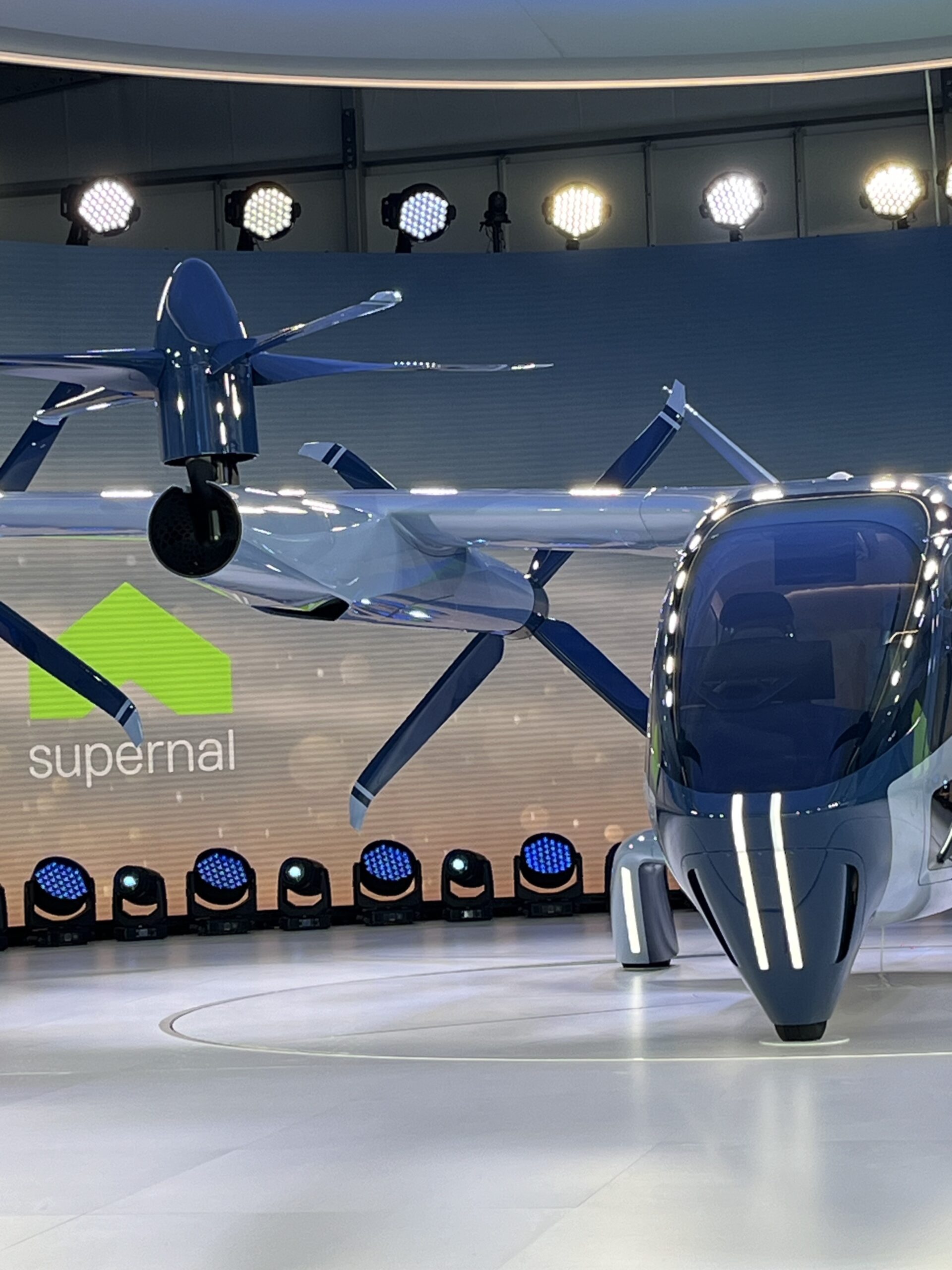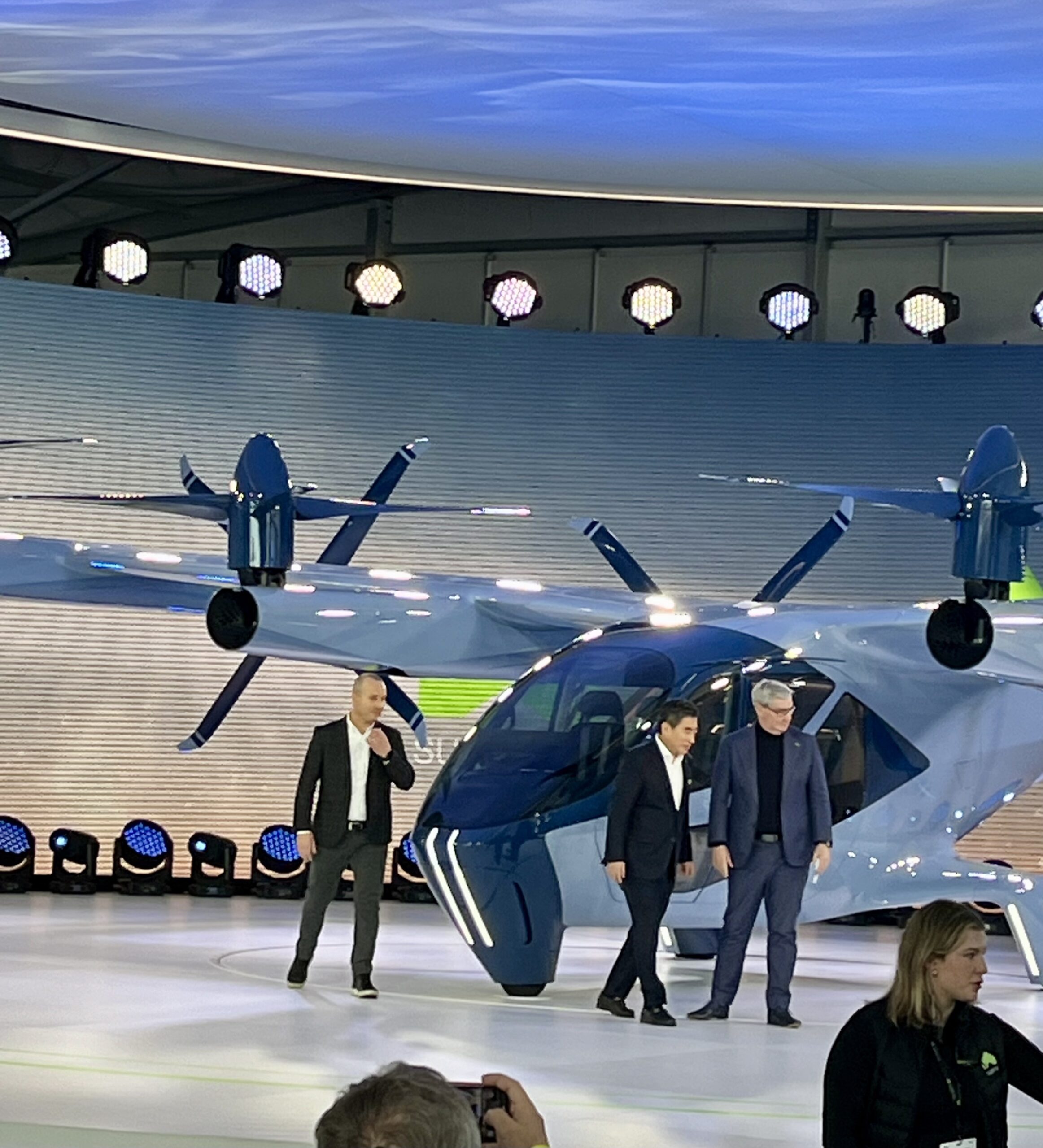From the Floor of CES: Supernal’s Newest Passenger eVTOL
 Supernal Unveils SA-2 at CES – “Kinetic Purism”
Supernal Unveils SA-2 at CES – “Kinetic Purism”
By: Dawn Zoldi
CES®, the most powerful tech event in the world, provides the world a stage for the breakthrough technologies and global innovators that will change the world. Yesterday, to kick off the first day of this unparalleled tradeshow, Supernal, a part of the Hyundai Motor Group, unveiled a physical prototype of its latest release, the SA-2 electric vertical takeoff and landing (eVTOL) aircraft. The company hopes to reshape how people see mobility and to redefine transportation with this stunning new vehicle.
Jaiwon Shin, President of Hyundai and CEO of Supernal, a seasoned engineer with over 30 years of experience leading NASA’s aeronautical research and development, explained the problems Supernal is trying to solve with its SA-2 aircraft. “Urban Areas are denser, roads more congested and the planet in desperate need of more sustainable solutions,” he said. “A 20 mile urban journey by car can take an hour in traffic. With advanced air mobility (AAM), the same journey can take just minutes,” he continued.
The hope is that commuters will routinely choose to fly safely and comfortably at 1500 feet AGL in a comfortable and quiet cabin, enjoying panoramic views of the city below, in Supernal’s SA-2 by 2028.
This reveal follows the company’s 2022 CES release of their vision for an AAM vehicle, the SA-1 eVTOL concept. Supernal engineers evolved that original concept into the current design to address the ever-expanding mobility needs of today. To get to this point, the design team narrowed down over 100 different vehicle shapes during its creative ideation phase to just one.
In describing his aircraft, Shin noted, “This is what happens when auto meets aero.”

 Supernal’s world renowned 600 person team remains laser-focused on advancing the AAM mission by building a great vehicle to serve and meet our customer needs, Shin explained. The SA-2 takes the best of an airplane, with a safe and smooth inflight experience, and merges it with the best of a helicopter’s ability to land and take off vertically, even in dense urban environments.
Supernal’s world renowned 600 person team remains laser-focused on advancing the AAM mission by building a great vehicle to serve and meet our customer needs, Shin explained. The SA-2 takes the best of an airplane, with a safe and smooth inflight experience, and merges it with the best of a helicopter’s ability to land and take off vertically, even in dense urban environments.This initially-piloted electric battery-powered, v-tailed aircraft can accommodate up to 4 passengers, in modular seats which can be reconfigured or even removed in between flight legs. It will be able to cruise at 120 mph at 1500 feet AGL across average trips of 25 to 40 miles. It has 8 rotors, 4 in front and 4 in back, which work together at all times and in all phases of flight. Importantly, during flight, they will remain as quiet as a modern dishwasher, registering only 45 decibels during cruise and 65 decibels during take off and landing.
CTO Ben Diachun elaborated that his team harnessed the full advantage of electric powertrain advancements to define this next gen aircraft. “Getting to this point took a lot of planning, studying and refinement.” That process, he explained, centered around 4 key principles: safety, sustainability, scalability and consumer-focus.
From a safety standpoint, “AAM must be safe with no compromises,” according to Diachun. His team iterated that primary focus on the safety of passengers and the public into a robust airframe architecture with redundant systems. They partnered with top tier aviation companies. They put the aircraft through rigorous design assurance testing. As a result, the SA-2 is equipped to fly in all weather, during both day and night. The company also continues working with government regulators on airspace management policy in furtherance of its safety mission.

 On the sustainability front, to run clean and quiet, Supernal leveraged state of the art lightweight battery technology. With support from Hyundai and Kia’s R&D Center, SA-2’s battery generates sufficient power to go from 0-60 mph during takeoff. Because battery tech will continue to improve over the next 20 years in terms of expanded range and capability, the company designed its advanced battery with upgradeability in mind.
On the sustainability front, to run clean and quiet, Supernal leveraged state of the art lightweight battery technology. With support from Hyundai and Kia’s R&D Center, SA-2’s battery generates sufficient power to go from 0-60 mph during takeoff. Because battery tech will continue to improve over the next 20 years in terms of expanded range and capability, the company designed its advanced battery with upgradeability in mind.This kind of forward-thinking ties into Supernal’s third goal, scalability. The aircraft had to be cost effective while maintaining the highest quality. “We will have to deliver 10s of 1000s of these to meet demands,” according to Diachun. “We will do this by leveraging Hyundai’s mass production capability,” he said. “This will bring down the barrier to entry for operators and everyone, who will benefit from this tech.”
Finally, the design had to be customer-centric. Supernal aims to bring the best in-car passenger experience to the sky. To make the inside of the vehicle as elegant as the vehicle behind it, Chief Creative Officer, Luc Donckerwolke, who has spent his entire career designing cars (including “Italian super sports cars”), closed the circle by purposely designing the aircraft’s interior around the passenger-user experience, from ergonomics, to performance and aesthetics. Donckerwolke describes the final outcome as “kinetic purism.”

 His team designed the front glass of the vehicles with inspiration from the eyes of a bee. The windows and doors allow light to blend into surfaces. In-flight light also adjusts to changing temperatures. The door’s butterfly-in hinges allow for better access.
His team designed the front glass of the vehicles with inspiration from the eyes of a bee. The windows and doors allow light to blend into surfaces. In-flight light also adjusts to changing temperatures. The door’s butterfly-in hinges allow for better access. Internally, the aircraft has 2 sections, a passenger cabin and flight deck, differentiated by different colors. The ergonomic seats were deliberately engineered to absorb vertical energy. Its storage areas contain all the modern conveniences in a premium cabin, such as cup and eyeglass holders. Supernal aims to win hearts and minds over to AAM through this level of human-centric design.
“We are moving AAM out of sci fi movies and into the real world,” Shin said in closing. “We are working to change the world of mobility for the progress of humanity.”
Keep an eye on the skies for Supernal’s SA-2 in the coming years, as they reach beyond and reach further to provide boundary-breaking aircraft to help create a future where the skies above us become the roads of tomorrow.
Read more:

 Dawn M.K. Zoldi (Colonel, USAF, Retired) is a licensed attorney with 28 years of combined active duty military and federal civil service to the U.S. Air Force. She is the CEO & Founder of P3 Tech Consulting and an internationally recognized expert on uncrewed aircraft system law and policy. Zoldi contributes to several magazines and hosts popular tech podcasts. Zoldi is also an Adjunct Professor for two universities, at the undergraduate and graduate levels. In 2022, she received the Airwards People’s Choice Industry Impactor Award, was recognized as one of the Top Women to Follow on LinkedIn and listed in the eVTOL Insights 2022 PowerBook. For more information, follow her on social media and visit her website at: https://www.p3techconsulting.com.
Dawn M.K. Zoldi (Colonel, USAF, Retired) is a licensed attorney with 28 years of combined active duty military and federal civil service to the U.S. Air Force. She is the CEO & Founder of P3 Tech Consulting and an internationally recognized expert on uncrewed aircraft system law and policy. Zoldi contributes to several magazines and hosts popular tech podcasts. Zoldi is also an Adjunct Professor for two universities, at the undergraduate and graduate levels. In 2022, she received the Airwards People’s Choice Industry Impactor Award, was recognized as one of the Top Women to Follow on LinkedIn and listed in the eVTOL Insights 2022 PowerBook. For more information, follow her on social media and visit her website at: https://www.p3techconsulting.com.
Miriam McNabb is the Editor-in-Chief of DRONELIFE and CEO of JobForDrones, a professional drone services marketplace, and a fascinated observer of the emerging drone industry and the regulatory environment for drones. Miriam has penned over 3,000 articles focused on the commercial drone space and is an international speaker and recognized figure in the industry. Miriam has a degree from the University of Chicago and over 20 years of experience in high tech sales and marketing for new technologies.
For drone industry consulting or writing, Email Miriam.
TWITTER:@spaldingbarker
Subscribe to DroneLife here.


